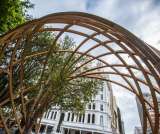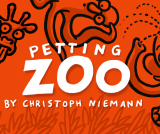First Published in
Jurgen Bey
Rotterdam-based Jurgen Bey's numerous projects include designing a crystal lamp for Swarovski, a table damask for Queen Beatrix's 25-year Jubilee, street furniture for an Amsterdam neighbourhood, and a nine-metre-long city bench in Tokyo.
"Studio Jurgen Bey designs for public spaces, interiors and applied art. Analysing the contents, searching for the relation of the things and its users, design supporting a story and the things having an interaction with its users are starting points for the projects," he says.
"As a designer I feel like an explorer travelling the world out of curiosity, or being sent with a mission, investigating, asking questions and making connections. To come back with stories. Stories told with design because that is my language."
Hella Jongerius
Hella Jongerius's projects date from 1993 and include objects in a wide range of mixed media such as polyurethane, latex, steel, felt, porcelain, glass, textiles, bronze, foam, plastics, and gold.
She says the common thread in her works is finding the right balance between an industrial-made serial product and a handmade unique piece, whereby both worlds remove their limits and products with identity appear.
New combinations of materials and techniques in archetypical shapes are typical of her products. Some are 'independent' and produced in a limited edition. There are also commissions, for example for Hermès Paris, Ikea Sweden, Maharam New York, Moss New York, Swarovski London, Royal Tichelaar Netherlands, and Vitra International.
Jongerius products form part of the collections of many national and international museums, as well as private collections. Museums also commission her work, for example 'My Soft Office' for the Museum of Modern Art New York. Phaidon published the first Jongerius book in 2003.
Li Edelkoort
Li Edelkoort, born in Holland in 1950, is one of the world's most renowned trend forecasters. She studied fashion and design at the School of Fine Arts in Arnhem, and on graduating became a buyer at the leading Dutch department store, the Bijenkorf. There she discovered her talent for sensing upcoming trends, and her unique ability to predict what consumers would want to buy several seasons ahead of time brought her to Paris in 1975, working full time as an independent trend consultant.
Since then, Edelkoort's work has pioneered trend forecasting as a profession; from innovative trend forums for Première Vision in the late 1980s to long-ranging lifestyle analysis for the world's leading brands in the 1990s and onwards. Since 1992, Edelkoort's magazines (View on Colour, InView and Bloom) have redefined the publishing medium and produced images that have become ideograms of our time. More recently, her work has evolved into the realms of education at the Design Academy Eindhoven, humanitarianism within the Heartwear foundation, and curatorship as she delves into the art and design domain illuminating museums and exhibits around the world.
Time magazine named her as one of the world's 25 Most Influential People in Fashion in 2003, while she received the Netherlands' Grand Seigneur Prize one year later for her work in fashion and textiles. Aid to Artisans honoured Edelkoort with a Lifetime Achievement Award in 2005 for her support of craft and design, and North Meets South, a design exhibit curated by Edelkoort, toured Saint Etienne, Paris, Stockholm and New York. Last year, an international touring exhibit honouring Edelkoort's forecasting as a landmark medium of social commentary was launched.
Ruudt Peters
Dutch conceptual jewellery artist Ruudt Peters, the noted head of the Jewellery Department at the Gerrit Rietveld Academy in Amsterdam from 1990 until 2000, will also share his creative concepts. Peters' masterpieces can be found in many private collections and in important museum collections such as the Museum für Angewandte Kunst, Vienna, the Stedelijk Museum, Amsterdam, the Musée des Arts Décoratifs, Montreal, the Danner Stiftung, Munich and the Cooper Hewitt Design Museum in New York.
Ruudt won the prestigious Francoise van den Bosch award in 2000 that is awarded every two years to a designer of jewellery and objects. He is the author of numerous publications.
Jewel in the Crown
Dutch jewellery and object designer Ruudt Peters, who lives and works in Amsterdam, Stockholm and Ravenstein, discusses some of his inspirations:
Who has been a key mentor for you, and why?
The Arte Povre artists from Italy like Kounellis, Mario Metz, Fabro. They were able to make art with a strong meaning from poor materials.
What are lifestyle influences impacting on Dutch design at present?
I think one of the qualities of Dutch-designed jewellery and architecture is that we have an open mind. Since the 17th century we've travelled all over the world. The Dutch have trust in the new generations and are able to give commissions to young artists, architects, designers. We can handle the risk of failure.
What are some of the main projects you will be working on this year?
My biggest project is to finish a square in 's-Hertogenbosch, Holland, where I designed the square adjoining an old church with a new fence and a fountain eight metres high. Furthermore, I am working on my Sefiroth (Tree of Life) project and will present this in the USA, Switzerland and Germany.
Could you share some aspects of your presentation at the Indaba?
I will present the development of Sefiroth at my lecture.
If you weren't a designer, what field would you like to work in?
I think I would be a monk or priest, I have a strong interest in religion.
What books are on your bedside table?
Hadrian Memories from Marguerite Yourcenar; Narcissus and Goldmund from Hermann Hesse; and The Possibility of an Island from Michel Houellebecq.
What is your favourite time of day and why?
In the morning at eight o'clock after meditation and swimming. The day starts afresh with an open view.




























